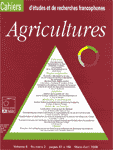Growth and mineral nutrition of sugar cane under planting or ratoon cropping conditions
Abstract
Dry matter production of sugarcane and its response to nitrogen fertilization decrease with crop age. This seems particulary important in dark clay soils (vertisols). The present study was carried out: i) to test nitrogen nutrition assessments according to critical curves for % N [5] in sugarcane stands, and ii) to determine whether decreases in the response of sugarcane to mineral fertilizer could be linked to the physical environment (soil properties) or to inherent properties of the stand (ageing). Shoot biomass and mineral concentration (N, P and K) were measured in sugarcane stands growing at increasing N supply rates under two ratoon crop conditions - 1st (R1) and 5th (R5) years after planting - and in a newly planted stand (V). The R1 and R5 ratoon crops grew on dark clay soil at rates 0, 75 and 150 kg N/ha. The new crop (V) grew on ferralitic soil at rates of 0, 150 and 300 kg N/ha - the latter was considered non-limiting for N and taken as control (Table 1). Dry matter accumulation was measured (5 replications) over a 3-5 month period (7-9 harvests), according to growth rates in the different treatments, and total N, P and K concentrations in shoots were measured in each sample. Radiation use efficiency (RUE) was calculated over the same growth period for each stand. The N concentration was correlated with sugarcane dry matter to determine the stand N nutrition levels [5]. The treatment curves were compared, and then compared to the critical curve for potential growth of C4 species [6]. Similar analyses were made to compare P and K nutrition levels between treatments. As shown in Figure 1, the top N nutrition level was only attained in highly fertilized new crops (V-N300, V-N150 and R1-N150). The fitted curve for N% of sugarcane crops with high N fertilization is lower than the critical curve for C4 species [6] (Figure 1), due to the very high specific leaf weight of sugarcane, which limits the nitrogen concentration in leaves when expressed on a dry matter basis. Expression of leaf N on an area basis (g N/m2) is suggested when comparisons with other C4 species are possible. Dry matter accumulation and RUE were drastically decreased in ratoon crops (Table 2), due to the lower N nutrition level in the R5 stand (which required 150 kg N/ha to reach the same N nutrition level as R1 without any N supply) (Figure 2). RUE and final yield remained lower in R5, suggesting the presence of limiting factors other than N, i.e. possibly P and K nutrition which also remained lower in the R5 stand, thus explaining the final yield differences (Figure 3). Furthermore, a marked interaction between N, P and K nutrition was noted for R1 (Figure 5), along with the effect of age and soil type on the P% and K% (Figures 4 and 6). We concluded that the curves linking N% and crop biomass provide a satisfactory assessment of N nutrition levels within sugarcane crops. Further research on sugarcane production should focus more closely on P and K nutrition.Downloads
Published
1999-03-01
How to Cite
Cruz, P., & Guillaume, P. (1999). Growth and mineral nutrition of sugar cane under planting or ratoon cropping conditions. Cahiers Agricultures, 8(2), 101–107 (1). Retrieved from https://revues.cirad.fr/index.php/cahiers-agricultures/article/view/30156
Issue
Section
Articles

